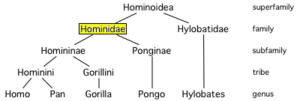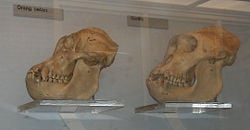Hominidae
| Hominids[1] | ||||||||||||||||||
|---|---|---|---|---|---|---|---|---|---|---|---|---|---|---|---|---|---|---|
| Australopithecus africanus reconstruction Australopithecus africanus reconstruction
| ||||||||||||||||||
| Scientific classification | ||||||||||||||||||
| ||||||||||||||||||
|
Hominidae is a taxonomic family of primates that includes humans, chimpanzees, gorillas, and orangutans. Collectively, members of Hominidae are known as the "great apes." Hominidae is one of two families of apes (superfamily Hominoidea]]. The other family is Hylobatidae, whose members include the gibbons and are known as the "lesser apes."
The term hominid technically refers to any member of the biological family Hominidae, extinct or extant (living). Originally, however, the term hominid was restricted to humans and their extinct relatives—those more closely related to humans (for example, australopithecines) than the other great apes, which were in a different family. This definition of hominid is still common in anthropology.
Classification
This classification has been revised several times in the last few decades. Originally, the group was restricted to humans and their extinct relatives, with the other great apes being placed in a separate family, the Pongidae. This definition is still used by many anthropologists and by lay people. However, that definition makes Pongidae paraphyletic, whereas most taxonomists nowadays encourage monophyletic groups. Thus many biologists consider Hominidae to include Pongidae as the subfamily Ponginae, or restrict the latter to the orangutans and their extinct relatives like Gigantopithecus. The taxonomy shown here follows the monophyletic groupings.
Another classification, which was historically common, was to divide the hominoids into three families, the Hylobatidae (gibbons), the Pongidae (orangutans, gorillas, chimpanzees, and bonobos), and the Hominidae (humans). In this case, the term hominid accurately applies to all human and humanlike forms, while great apes applies only to gorillas, chimpanzees (and bonobos), and orangutans.
Especially close human relatives form a subfamily, the Homininae. Some researchers go so far as to include chimpanzees and gorillas in the genus Homo along with humans, but it is more commonly accepted to describe the relationships as shown here.
Many extinct hominids have been studied to help understand the relationship between modern humans and the other extant hominids. Some of the extinct members of this family include Gigantopithecus, Orrorin, Ardipithecus, Kenyanthropus, and the australopithecines Australopithecus and Paranthropus.
The exact criteria for membership in the Homininae are not clear, but the subfamily generally includes those species which share more than 97% of their DNA with the modern human genome, and exhibit a capacity for language or for simple cultures beyond the family or band. The theory of mind including such faculties as mental state attribution, empathy and even empathetic deception is a controversial criterion distinguishing the adult human alone among the hominids. Humans acquire this capacity at about four and a half years of age, whereas it has neither been proven nor disproven that gorillas and chimpanzees develop a theory of mind.[2] This is also the case for some new world monkeys outside the family of great apes, as, for example, the capuchin monkeys.
However, without the ability to test whether early members of the Homininae (such as Homo erectus, Homo neanderthalensis, or even the australopithecines) had a theory of mind, it is difficult to ignore similarities seen in their living cousins. Despite an apparent lack of real culture and significant physiological and psychological differences, some say that the orangutan may also satisfy these criteria. These scientific debates take on political significance for advocates of Great Ape personhood.
In 2002, a 6–7 million year old fossil skull nicknamed "Toumaï" by its discoverers, and formally classified as Sahelanthropus tchadensis, was discovered in Chad and is possibly the earliest hominid fossil ever found. In addition to its age, Toumaï, unlike the 3–4 million year younger gracile australopithecine dubbed "Lucy", has a relatively flat face without the prominent snout seen on other pre-Homo hominids. Some researchers have made the suggestion that this previously unknown species may in fact be a direct ancestor of modern humans (or at least closely related to a direct ancestor). Others contend that one fossil is not enough to make such a claim because it would overturn the conclusions of over 100 years of anthropological study. A report on this finding was published in the journal Nature on July 11, 2002. While some scientists claim that it is merely the skull of a female gorilla, others have called it the most important hominin fossil since Australopithecus.
In addition to the Tourmai fossil, some experts use evidence from the genome to argue that the species associated with the chimpanzees and proto-humans split interbred over a long period of time, swapping genes, before making a final separation. A paper, whose authors include David Reich and Eric Lander (Harvard and the Massachusetts Institute of Technology (MIT)), was published in journal Nature in May 2006.
It is generally believed that the Pan/Homo split occurred about 6.5–7.4 million years ago, but the molecular clock (a method of calculating evolution based on the speed at which genes mutate) suggests the genera split 5.4–6.3 million years ago. Previous studies looked at average genetic differences between human and chimp. The new study compares the ages of key sequences of genes of modern humans and modern chimps. Some sequences are younger than others, indicating that chimps and humans gradually split apart over a period of 4 million years. The youngest human chromosome is the X sex chromosome which is about 1.2 million years more recent than the 22 autosomes. The X chromosome is known to be vulnerable to selective pressure. Its age suggests there was an initial split between the two species, followed by gradual divergence and interbreeding that resulted in younger genes, and then a final separation.
Classification
- Family Hominidae: humans and other great apes; extinct genera and species excluded.[1]
- Subfamily Ponginae
- Genus Pongo
- Bornean Orangutan, Pongo pygmaeus
- Pongo pygmaeus pygmaeus
- Pongo pygmaeus morio
- Pongo pygmaeus wurmbii
- Sumatran Orangutan, Pongo abelii
- Bornean Orangutan, Pongo pygmaeus
- Genus Pongo
- Subfamily Homininae
- Tribe Gorillini
- Genus Gorilla
- Western Gorilla, Gorilla gorilla
- Western Lowland Gorilla, Gorilla gorilla gorilla
- Cross River Gorilla, Gorilla gorilla diehli
- Eastern Gorilla, Gorilla beringei
- Mountain Gorilla, Gorilla beringei beringei
- Eastern Lowland Gorilla, Gorilla beringei graueri
- Western Gorilla, Gorilla gorilla
- Genus Gorilla
- Tribe Hominini
- Genus Pan
- Common Chimpanzee, Pan troglodytes
- Central Chimpanzee, Pan troglodytes troglodytes
- West African Chimpanzee, Pan troglodytes verus
- Nigerian Chimpanzee, Pan troglodytes vellerosus
- Eastern Chimpanzee, Pan troglodytes schweinfurthii
- Bonobo (Pygmy Chimpanzee), Pan paniscus
- Common Chimpanzee, Pan troglodytes
- Genus Homo
- Human, Homo sapiens sapiens
- Genus Pan
- Tribe Gorillini
- Subfamily Ponginae
In addition to the extant species and subspecies above, archaeologists, paleontologists, and anthropologists have discovered numerous extinct species. The list below are some of the genera of those discoveries.
- Subfamily Ponginae
- Gigantopithecus†
- Sivapithecus†
- Lufengpithecus†
- Ankarapithecus†
- Ouranopithecus†
- Subfamily Homininae
- Homo - Humans and their immediate ancestors
- Oreopithecus†
- Paranthropus†
- Australopithecus†
- Sahelanthropus†
- Orrorin†
- Ardipithecus†
- Kenyanthropus†
See also
Template:3d commons
- Kinshasa Declaration on Great Apes
- Ape extinction
- Declaration on Great Apes
- Evolution of Homo sapiens
- Evolutionary neuroscience
- Graphical timeline of human evolution
- Great ape language
- Great Ape Project
- List of apes - notable individual apes
- The Mind of an Ape
- Great Ape research ban
- Great Apes Survival Project
ReferencesISBN links support NWE through referral fees
- ↑ 1.0 1.1 C. Groves, "Order Primates," "Order Monotremata," (and select other orders). Page(s) 181-184 in D. E. Wilson and D. M. Reeder, eds., Mammal Species of the World, 3rd edition, Johns Hopkins University Press (2005). ISBN 0801882214.
- ↑ Heyes, C. M. (1998). THEORY OF MIND IN NONHUMAN PRIMATES. Behavioral and Brain Sciences. bbs00000546.
External links
- Additional information on great apes
- NPR News: Toumaï the Human Ancestor
- Hominid Species at talkorigins.org
- For more details on Hominid species, including excellent photos of fossil hominids
- New Scientist 19 May 2003 - Chimps are human, gene study implies
- Scientific American Magazine (April 2006 Issue) Why Are Some Animals So Smart?
| Extinct primate families by suborder |
|---|
| Strepsirrhini: Cheirogaleidae · Lemuridae · Lepilemuridae · Indriidae · Daubentoniidae · Lorisidae · Galagidae
Haplorrhini: Tarsiidae · Cebidae · Aotidae · Pitheciidae · Atelidae · Hylobatidae · Hominidae · Cercopithecidae |
Credits
New World Encyclopedia writers and editors rewrote and completed the Wikipedia article in accordance with New World Encyclopedia standards. This article abides by terms of the Creative Commons CC-by-sa 3.0 License (CC-by-sa), which may be used and disseminated with proper attribution. Credit is due under the terms of this license that can reference both the New World Encyclopedia contributors and the selfless volunteer contributors of the Wikimedia Foundation. To cite this article click here for a list of acceptable citing formats.The history of earlier contributions by wikipedians is accessible to researchers here:
The history of this article since it was imported to New World Encyclopedia:
Note: Some restrictions may apply to use of individual images which are separately licensed.




